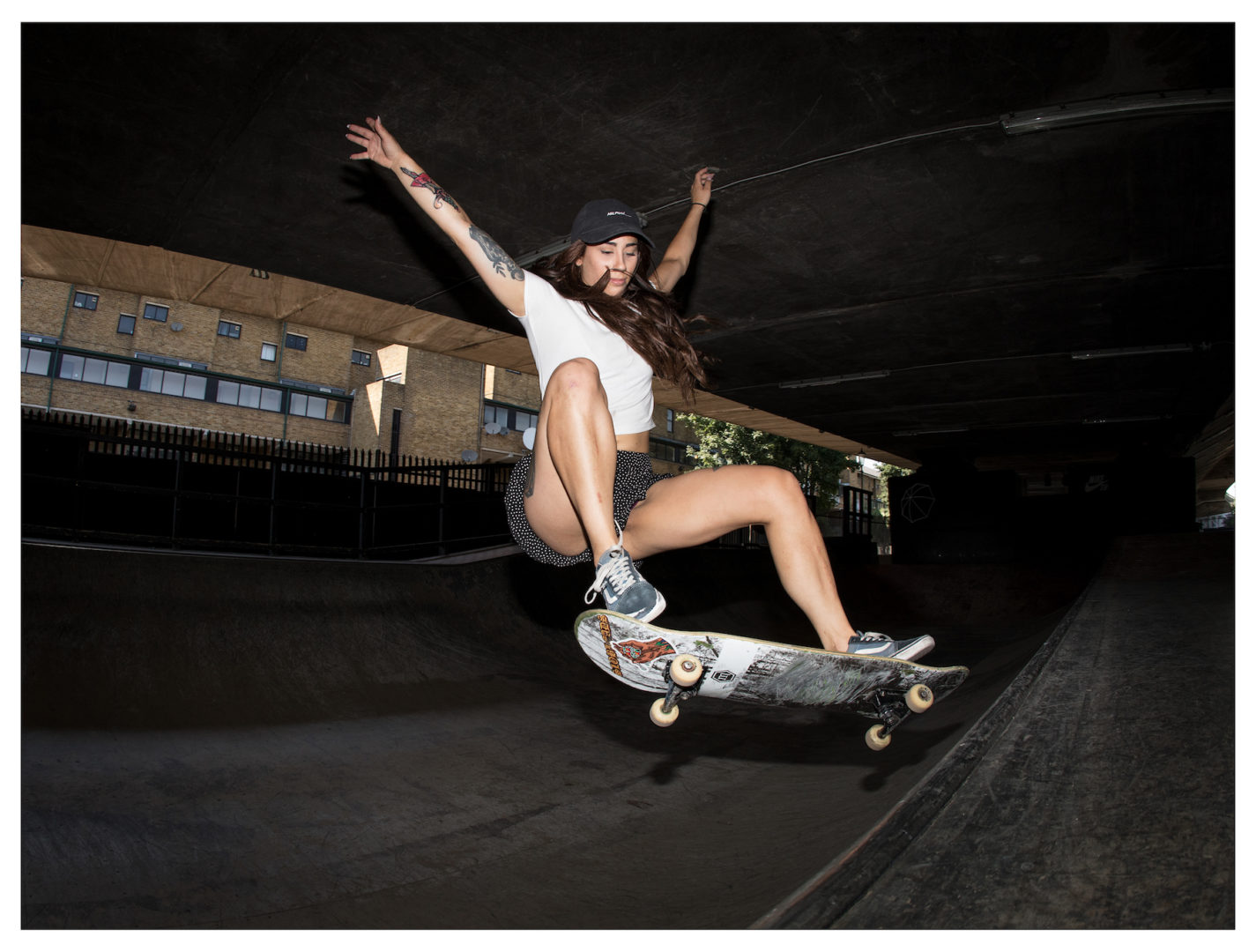Got some time to kill? Check out these rad vids directed by The Berrics - Skate Girls on Urban Outfitters TV 💘
GIRLS BELONG IN THE (SKATE) KITCHEN
Just a little bit in love with this brilliant TED talk by Nina Moran of The Skate Kitchen... Strength in numbers, teaching each other something new & holding each other up. An awesome message by and awesome woman. x
BABES & BRUSIES BY GIRLS ARE AWESOME - CARLITA THE GYPSY
Loving this new series of articles called Babes & Bruises by Girls Are Awesome telling stories of some amazing ladies & how they earned their war wounds.
IMAGE FROM WWW.GIRLSAREAWESOME.COM
Introducing our new series of stories, where girls who ride tell us about epically bailing and show us their bloody kneecaps. No pain, no gain, right?
- GIRLS ARE AWESOME
-
Girls who ride know that failing is part of the game. After all, no pain, no gain, right? So welcome to “Babes & Bruises”: a series where we ask riders to show us their brag-worthy bruises, tell us how they went down and explain how they kept pushing afterwards, bloody kneecaps be damned.
Meet 23-year-old, London-based shredder Carla Calero, aka Carlita the Gypsy. Although she claims to suck at riding ramps, she’s been a staple of the UK skate scene for quite a few years and has been covered by mags like Coven and Girls Skate UK. Like many other skaters, she’s had to deal with a pretty inconvenient injury—so we got the lowdown on what happened and how to keep the stoke alive when you’re forced into a temporary break-up with your skateboard.
IMAGE FROM WWW.GIRLSAREAWESOME.COM
GIRLS ARE AWESOME: Hi, Carla. How did you get into skating and how often do you hit the streets?
I just wanted to learn; I always found skateboarding such an interesting thing. It’s a way to express yourself. I usually skate like twice per week, probably six hours in total. It depends on the weather, obviously.
Do you prefer street skate or ramps?
I’d rather skate street; I’m terrible at ramp. I feel more comfy hitting a rail or a bank, but I can also have fun on a ramp, even though I suck.
Tell us about your injury. What went down?
I’ve been in the game for five years and last year I tore my ACL [Anterior Cruciate Ligament] and meniscus.
________
BECOME A PART OF A NEW GROUNDBREAKING SURVEY FINDING OUT THE RELATIONSHIP BETWEEN WOMENS MENTAL HEALTH & ADVENTURE SPORTS
"I ride to clear my head" is something that you hear many women talk about in terms of riding no matter whether that be a skateboard, bicycle or motorcycle. No matter which facet of outdoors & adventure you are involved in, the common place factor between many of us seems to be the positive effect that time spent in the places you love doing the things you love has on your mind & wellbeing. It’s this very relationship between womens mental health & the outdoors that has led the people behind Women In Adventure and Shextreme to conduct a groundbreaking survey into the relationship between womens mental health & adventure & the outdoors & you can be a part of it.
The first survey of its kind to be conducted, with the help of as many women experiencing outdoor & adventure sports as possible, the team aim to be able to put the findings to good use to empower women & raise awareness on mental health issues but also to communicate their findings with brands, businesses, initiatives & news outlets to create a better understanding.
_
“Instinctively we know being outside is good for our soul, it makes us feel alive” says Women In Adventure. “However, there is a lack of accessible information showing how and to what extent it impacts our lives. Aside from proving there is a positive association between the outdoors and mental wellbeing, we would like this project to empower women and raise awareness of an often under-discussed topic.” - Women in Adventure
_
We think its an incredible initiative with the results being put to brilliant use to highlight & address womens mental health & the ways we deal with mental health issues. If you have a spare few minutes its well worth the time. All information you give will be kept anonymous but if you choose your input can be added to the advice & inspiration page of their website (well worth a look to find some inspiring words from fellow women experiencing the outdoors from their own perspective).
FEMALE MOTORCYCLE RACER RIPS A NEW TRAIL BY KRISTIN MARGUERITE DOIGE FOR GOOD SPORTS
P // www.blog.motorcycle.com
Inspiring interview with female flat track legend Shana Texter by Kristin Marguerite Doige for GOOD SPORTS.
____________________
With a blond ponytail whipping out of her helmet, standing at five feet tall, weighing just 95 pounds, Shayna Texter is the all-American, fresh-faced female rider leading the pack in American Flat Track, a highly competitive, male-dominated motorcycle racing sport.
She’s one of just two professional female riders currently competing in the sport — and she’s thriving. Texter posted five wins in 2017 and finished the American Flat Track Singles championship series in third place. In 2011, she became the first female to win a main event in AFT history with her singles win at Knoxville Raceway and followed up that landmark win with another seven during the next three years. Recently, she trained with Jay Leno.
She is the latest generation from a family of Flat Track racers, and competes alongside her successful brother, Cory Texter, who is also a professional in the series and races in the AFT Twins class. They are one of the few brother-sister duos to compete in the highest level of motorsports.
One of her greatest personal setbacks was the passing of her father in 2010, who was also a professional flat track racer and served as her inspiration to get involved with the sport.
But Texter’s determination is in her blood. A fierce and respected competitor on the race track, she’s a kind, thoughtful soul in her free time — enjoying country music, fishing, and time with family and friends. She’s also a devoted advocate interested in inspiring the next generation of girls. Here’s what she had to say when GOOD caught up with her:
Is being petite an advantage in your sport? Did it affect which sports you played/participated in as a child?
My size never affected which sports I played as a child. Beside motorcycles, my second love growing up was soccer. I played soccer for more than 10 years on a travel team and for my school before calling it quits in 10th grade to focus primarily on flat track. Being petite has its advantages and disadvantages in flat track racing. The tracks with high speeds and a draft, my smaller body allows me tuck more down the straightaway and cut through the wind better. However, the smaller tracks where you really have to muscle the bike around and use your body to get the bike turned is more of a struggle for me. I also struggle a lot more with rear-end grip on slippery racetracks, because I do not have the weight and the body size like some of my competitors do to get my body up over the rear wheel.
How does the sport balance athleticism with safety? How do you view it personally?
The American Flat Track series tries to put safety at the top. At every round, riders have to wear a full leather suit, leather gloves, boots, a DOT-approved helmet, and back protector. The tracks that have walls also have air bag fencing that is deployed in front of the walls in the high impact sections of the racetrack. American Flat Track also has multiple observers to check on the racetrack at all times throughout the day for safety, and we have lights and certain flags to notify us riders while on the track.
LIVIA LANCELOT - THE FIRST EVER WOMENS WORLD CHAMPION IN THE HISTORY OF MOTOX - INTERVIEW BY PAULA VIIDU FOR GIRLS ARE AWESOME
THIS 🙌
In 2008, French motocross rider Livia Lancelot won the FIM Women’s Motocross World Championshipand became the first ever women’s world champion in the history of motocross. This victory came right in the middle of a shifting conversation within the world of action sports: rather than talking about the best champions, people were increasingly talking about why more women weren’t becoming the best champions. Gender imbalance and action sports have traditionally gone hand in hand, and motocross is no exception. However, things are tangibly improving on that front: since the Powder Puff National in 1974 – the first big female motocross race in the U.S. – we’ve seen an influx of competitions pop up specifically giving props to female athletes. There’s the WMX championship series, the X Games, the Endurocross series, just to name a few; and in the 2000s, women’s motocross became an official part of the AMA Pro National series, one of the world’s most prestigious motocross championships. And it’s not just about organisations moving to include women, too. Traditional motocross audiences want to see more women excelling in the sport, as exemplified by Vicki Golden: despite being the first woman in the Freestyle Motocross competition at LA’s X Games 2013 and despite competing against prominent male riders, she earned a bronze medal based off of real-time voting from people tuning into the competition on Twitter.
IMAGE: KAWASAKI.SK
The impact of including women in motocross culture has been so tangible that women are increasingly participating in the sport even in countries like Iran, where women are banned from riding motorcycles in public. On the wave of this momentum, Girls are Awesome caught up with Livia about what it’s like being the only girl at the start line and what the women’s scene in motocross is like today.
IMAGE: LIVIALANCELOT.COM
LEVIS X VC FOR THE STYLIST MAGAZINE
Great to get a ride in before the CAMP VC madness started in Wales with the lovely people of LEVIS & STYLIST MAGAZINE ❤️
READ THE FULL ARTICLE HERE : http://pages.stylist.co.uk/fashion/breaking-up-the-boys-club/
'RAISE BRAVE GIRLS, ENCOURAGE ADVENTURE ' - CAROLINE PAUL
If you do one thing today watch this.
Read More






